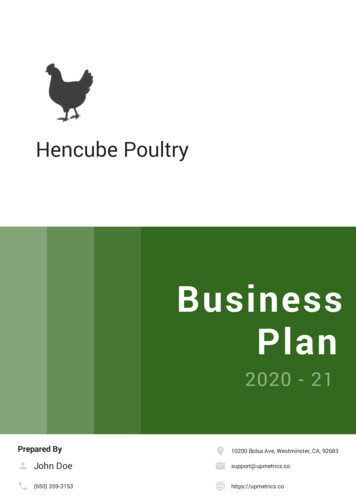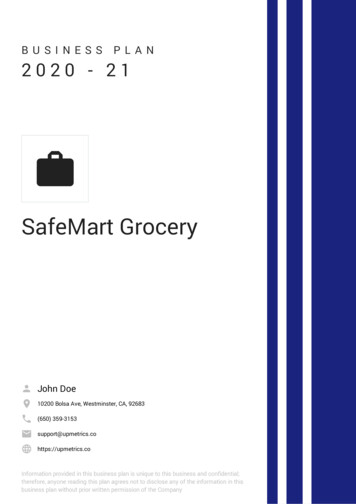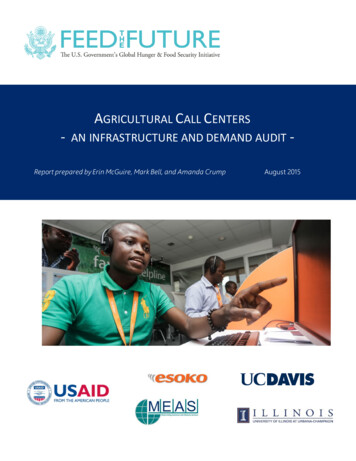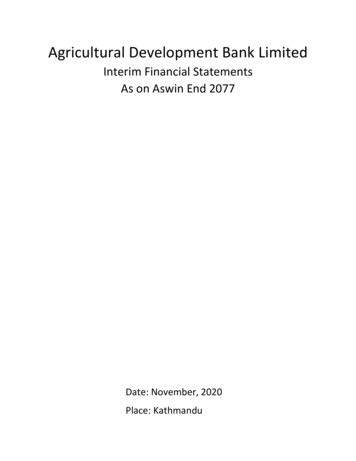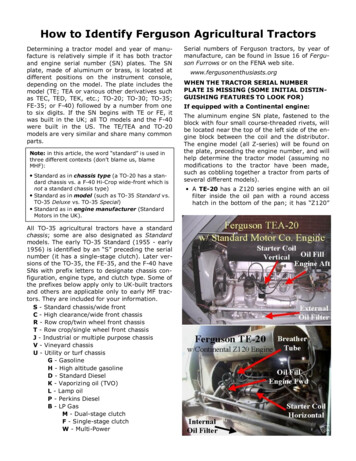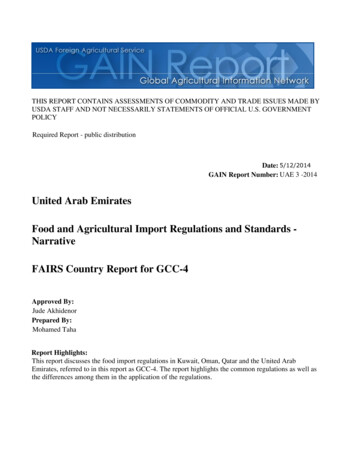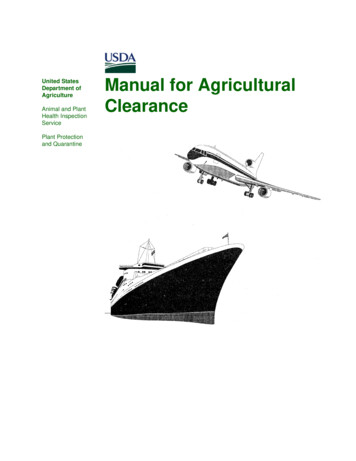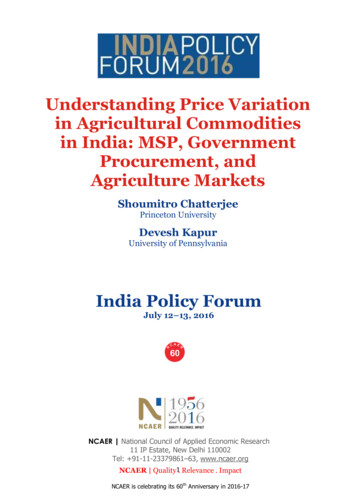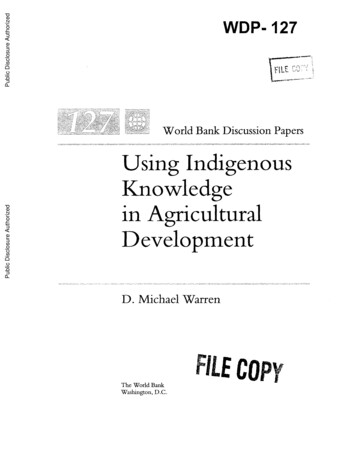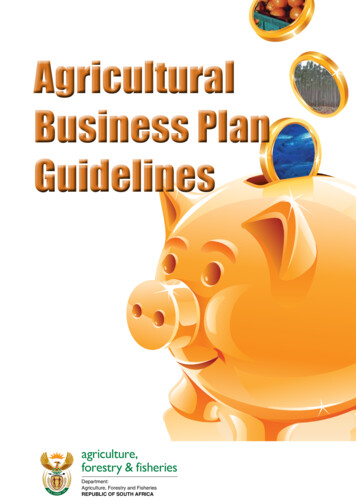
Transcription
AgriculturalBusiness PlanGuidelinesagriculture,forestry & fisheriesDepartment:Agriculture, Forestry and FisheriesREPUBLIC OF SOUTH AFRICA
Agricultural Business Plan GuidelinesFebruary 2012Directorate Co-operative and Enterprise DevelopmentDEPARTMENT OF AGRICULTURE, FORESTRY AND FISHERIES2012Printed and published byDepartment of Agriculture, Forestry and FisheriesDesign and layout byDirectorate Communication ServicesPrivate Bag X144, Pretoria 0001
Table of contents1. Executive summary .12. Problem statement .13. Objectives .24. Part I .24.1 Overview of agricultural business plan guidelines .24.2 Definition of a business plan .24.3 Reasons for drafting a business plan .24.4 The benefits of a well-prepared business plan .34.5 Reasons for business failures .34.5.1Management reasons .34.5.2Financial factors .44.5.3Other .44.6 Common mistakes in the drafting of business plans .44.6.1Cash flow .44.6.2A vague business plan .44.6.3Unrealistic assumptions .44.6.4Risks .44.6.5Competition .44.6.6Suppliers .45. Part II .55.1 Methodologies and sources for information collection .55.1.1Methodology .55.1.2Sources .55.1.2.1Find a similar business in or around your area .55.1.2.2 Scan local newspapers or other media .55.1.2 3Government departments . .55.2 Step-by-step approach in drafting a business plan .5New farming enterprise .55.3 Recommended production system size .65.3.1Recommended minimum farm size for cattle .65.3.2Recommended farm size for grain production under dry land .65.3.3Recommended minimum farm size for vegetables .65.3.4Recommended minimum farm units for broilers .65.3.55.2.1Recommended minimum farm units for layers .65.4 Supporting documents required by financiers/investors/sponsors .66. Available funding programmes and other funding institutions .77. Part III .77.1 Framework for an agricultural business plan .77.2 Finances . 127.2.1Cash flow . 127.2.2Balance sheet . 147.2.3Income statement . 15
Agricultural Business Plan Guidelines1.1EXECUTIVE SUMMARYThe Medium Term Strategic Framework (MTSF) mandate accentuates the need to create a nation united indiversity to work together to ensure a more equitable distribution of the benefits of economic growth and toreduce inequality. Cognisance of the differentiated and heterogeneous resource requirements in agriculturalentities in terms of challenges, opportunities and potentialities has been the underlying reason for the approach taken in this intervention.This document is a result of numerous calls for help from potential farmers, aspiring entrepreneurs andgovernment officials from all the provinces requesting guidance with drafting bankable business plans.Research has shown that prospective entrepreneurs are not familiar with the contents of their business plan,because they seldom contribute (input) into the development of a business plan. This is a recipe for disaster.Consultants/agencies that draw up business plans for these entrepreneurs operate commercial businessesand they are seldom interested in whether the outcomes of the business plans are attained.The intention of this document, therefore, is to provide guidance and to capacitate entrepreneurs and prospective entrepreneurs in the agricultural sector to access opportunities successfully and in managing andsustaining enterprising activities from farm level through to the entire agricultural value chain. Studies haveshown that low-income entrepreneurs are more vulnerable to risks than their high- income counterparts.Grant beneficiaries operating agricultural activities often lack knowledge and expertise in managing the financial aspects of the business, resulting in them being exposed to the smallest economic shocks.The Business Plan Guidelines is developed to provide comprehensive, simplified and not too complicatedinformation required by funding institutions/investors/sponsors for prospective farmers/entrepreneurs wanting to make inroads into the agricultural sector.Details on the purpose and process of drafting a bankable business plan will be provided by unpacking, withexplanations, the different components of the business plan. Information on how to access the funding programmes will be provided.It is envisaged that the professionals engaged in Business Plan Formulation, i.e. Agricultural Scientists including Economists from the provincial offices; government institutions entrusted with the responsibility ofdistributing financial assistance for agribusinesses/entrepreneurs like the AgriBEE fund, CASP and Mafisaand those individuals seeking to start their businesses, will find these guidelines useful.The structure of the document will provide the objectives for the Business Plan Guidelines and encompassPart I, Part II and Part III as detailed below.Part I of the guidelines will provide an overview of the Business Plan Guidelines; the definition of the BusinessPlan; the reasons for drafting the Business Plan; the benefits of a good business plan; the failures of businesses and, finally, common mistakes in drafting business plans.Part II of the guidelines will attempt to cover methodologies and sources that can be utilised in informationcollection; the steps to take in preparing the business plan/proposal and the pertinent information required byfunding institutions/investors to ensure successful applications/bankable business plans.Part III will provide a generic format/structure that can be used.2.PROBLEM STATEMENTOne of the great challenges facing the agricultural sector is to increase the number and variety of viable andsustainable economic agricultural enterprises. The global downturn in the past few years has further amplified this challenge. Government is of the view that strengthening competitiveness and promotion of smalland medium-sized enterprises and cooperatives remain cornerstones for the growth of the economy and thecreation of decent work opportunities. In the agricultural sector, it is found that entrepreneurial and management skills/abilities are lacking in many individuals who are trying to access enterprising opportunities.Employment opportunities in the commercial agricultural sector were limited to unskilled labour where the incomes were very low. Downstream (input suppliers) and upstream (processors of food and fibre) were in thehands of a few commercial producers, depriving rural people of economic opportunities. These factors were
2Department of Agriculture, forestry and FisheriesAgricultural Business Plan Guidelinesresponsible for creating the extreme dualism and inequality in the sector as well as the uneven income distribution. Notably, agriculture comprises a first and second economy, both competing for the same resourcesand markets. Participants in the second economy were compromised owing to limitations in accessing large,stable and sustainable markets.A business plan can be used as a powerful sales document for raising money. A business plan is a prerequisit for engaging with a venture capitalist, and/or investors. To raise funds for a start-up business ventureor to raise additional capital, your document must fulfil the requirements of a funding institution or sponsorand this will give the reader an insight into what you will be doing in your proposed or existing business. Theorganisations that lend money to your business also want to get a return on their investment. They want a‘safe’ investment with relatively low risk. A thorough business plan can accomplish this.Many projects receiving funding from government programmes and/or sponsors and and/or loans from funding institutions have either failed or failed to meet their financial obligations.3.OBJECTIVES3.1To provide a guide to existing and new entrepreneurs on the practicalities of business plans.3.2To contribute to better managed business ventures.3.3To empower and capacitate entrepreneurs in understanding the various elements of the business plan.3.4To provide details and composition of the relevant information required for drafting business plans.3.5To explain the merits of a good business plan3.6To enhance and support decision making in SMMEs4.PART 14.1Overview of agricultural business plan guidelinesYour plan will assist you in what to do and when to do it. Entrepreneurs should use their business plan for thecritical start up. Entrepreneurs should use their business plan for start up of operations; or during expansionof operations to ensure that they stay on target and within the budget at all times.Prospective entrepreneurs involved in the process of formulating their own business plans from the onset, willbe more objective and critical towards their business than if it is prepared by outside consultants or individuals.4.4The benefits of a well-prepared business planA business plan will provide you with a clear strategy and objectives. A good business plan will give you direction and keep you and your staff focused. In writing your business plans you may make mistakes which canbe corrected on paper prior to implementing your plans, which can save you money.The business plan demonstrates the seriousness of your intentions to banks, investors, colleaguesand employees. It can be used as a measure for you to foresee/anticipate problems and take appropriate action timeously. All your ideas can be incorporated into the business plan to become a reality.The planning process affords you the opportunity of adopting a step-by-step approach in preparing for thefuture achievement and risks of your business vent
4 department oF aGriculture, Forestry and Fisheries aGricultural business plan Guidelines 5 cstoes an aets Te bsness a contact ot te collecton of sc nfoaton to an aoate oansaton sc as a et eseac coan oenent eatents 5.1.2s 5.1.2.1. Find a similar business in or around your area
